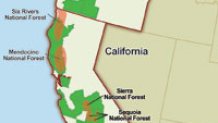Illicit marijuana farming in remote corners of California is threatening already endangered salmon and steelhead trout by sucking up water from streams. Growers are cutting away the forest and poisoning the Pacific fisher, the northern spotted owl and other wildlife with pesticides and fertilizers. Pot grown indoors consumes as much electricity for air-conditioning, lightening, fans and humidifiers as 1 million homes.
As California prepares to regulate medical marijuana farming in the midst of an historic four-year drought and possibly legalize its recreational use, environmentalists are looking forward to ecological protections being demanded of cannabis growers.
"There are some really serious environmental impacts associated with the industry," said Jennifer Carah, a freshwater ecologist for the Nature Conservancy in California.
And although the state is now turning attention to the degradation pot farms can cause, unscrupulous growers will remain a problem — whether because they are unwilling to pay new fees and taxes or because they are export marijuana to states where it is not legal. And because marijuana remains illegal under federal law, farms may stay hidden in forested, undeveloped watersheds so as not to gain the attention of federal authorities.
"The black market problem is not necessarily going to go away in the face of recreational legalization in California," Carah said. "It's still going to be an issue more than likely."
California became the first state to legalize marijuana for medical use in 1996, but until last fall, the industry was unregulated and environmental protections were lacking. Legislation signed by Gov. Jerry Brown in October calls for the state to begin issuing permits for commercial growers in 2018.
Local
California will award licenses only to commercial growers who also have local permits while giving leeway to communities to decide what kind of farms they want within their borders. Some cities are already approving applications for marijuana cultivators — among them Desert Hot Springs in Riverside County and Adelanto in San Bernardino County — and wrestling with its particular demands. Other counties, Nevada and Shasta counties for example, have outlawed outdoor cultivation.
The new regulations come as Californians will vote in November on whether to approve recreational use -- now that backers of an initiative have collected enough signatures to put it on the ballot.
State agencies will have the authority to regulate marijuana cultivation — to enforce compliance with water rights and to require that cannabis farms meet other existing environmental regulations.
"So bringing it out of the dark and regulating it like any other agricultural crop," Carah said.
Hezekiah Allen, executive director of the California Growers Association, said its 550 members, small, independent growers throughout the state, want the ban on cannabis cultivation to end, but the association has not yet taken a position on the current ballot initiative.
After two decades of operating without regulations, growers are now facing licensing, inspections and other requirements.
"That was a tectonic shift in cannabis policy here in California and the dust hasn't quite settled yet," he said.
Allen said that his organization was eager to support regulation because some of the marijuana growers are running sustainable farms, storing and recycling water and not damaging aquatic habitat.
"But there's also some of the most egregious environmental crimes in the country taking place," he said. "And with the absence of regulation and the absence of transparency in the marketplace, there's no way to differentiate between a criminal grower and a legitimate grower."

California's agricultural industry uses 35 million acre feet of water a year -- the amount of water needed to cover an acre with a foot of water. The cannabis industry uses only 10,000 to 15,000 acre feet, he said. Alfalfa for example uses several million gallons of water a year, he said.
The California market is large -- $10 billion to $30 billion by some estimates -- and the industry expects it to continue to grow. Between 60 to 70 percent of the marijuana consumed in the United States is thought to be grown in California -- although those estimates also are uncertain.
A state report prepared on marijuana policy, whose steering committee was headed by Lt. Gov. Gavin Newsom, noted that environmental protection was a particular concern given the size of the cannabis industry in California. Rural producing regions include the so-called "Emerald Triangle" counties or Humboldt, Mendocino and Trinity. Other marijuana cultivation takes place on public lands -- the 1.3 million acres of state park land and the more than 8 million acres of national forest and wilderness, the report said.
"This is a challenge for enforcement agents and regulators," it said. "It also means cracking down on these illegal grows will take a funded and coordinated effort from federal, state and local officials to ensure our public lands are being protected."
One of the most serious problems has been water diversion by growers who do not have water rights. Marijuana farms have dried up streams, killing fish and other animals and posing a particular threat to the threatened Coho salmon. Dirt that runs off into streams has smothered the fish habitat.
Heavy use of fertilizers, pesticides and herbicides has polluted waterways and killed animals. Eighty percent of dead Pacific fishers, a wolverine that hunts small rodents, that were recovered in the wildness had been exposed to rat and other poison, researchers with the University of California found.
As far as electrical use, in 2012, 3 percent of California's went toward growing marijuana indoors, according to another University of California study.
Environmentalists say that the state will need at least $25 million a year to regulate cannabis cultivation and enforce environmental regulations and more than $100 million a year for the first five years to clean up the damage done by illegal marijuana farms and to restore the land they used.
If the ballot initiative is approved, the state would impose an excise tax on retail sales of 15 percent of sales price, and cultivation taxes of $9.25 per ounce of flowers and $2.75 per ounce of leaves. Tax revenues to be collected could be at a minimum $200 million a year for environmental protection, Carah said.
"We feel pretty pleased with the seriousness with which the legislature and the initiative drafters have taken the environmental impact," she said.



